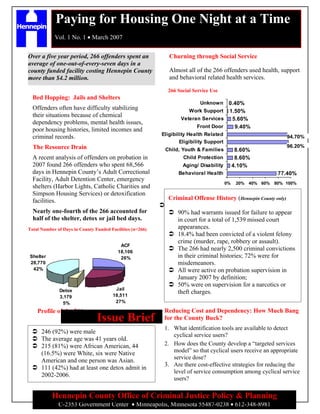
Paying for Housing One Night at a Time: How Frequent Shelter Stays Cost the County Millions
- 1. Paying for Housing One Night at a Time Vol. 1 No. 1 • March 2007 Over a five year period, 266 offenders spent an Churning through Social Service average of one-out-of-every-seven days in a county funded facility costing Hennepin County Almost all of the 266 offenders used health, support more than $4.2 million. and behavioral related health services. 266 Social Service Use Bed Hopping: Jails and Shelters Unknown 0.40% Offenders often have difficulty stabilizing Work Support 1.50% their situations because of chemical Veteran Services 5.60% dependency problems, mental health issues, Front Door 9.40% poor housing histories, limited incomes and Eligibility Health Related criminal records. 94.70% Eligibility Support The Resource Drain 96.20% Child, Youth & Families 8.60% A recent analysis of offenders on probation in Child Protection 8.60% 2007 found 266 offenders who spent 68,566 Aging/ Disability 4.10% days in Hennepin County’s Adult Correctional Behavioral Health 77.40% Facility, Adult Detention Center, emergency 0% 20% 40% 60% 80% 100% shelters (Harbor Lights, Catholic Charities and Simpson Housing Services) or detoxification facilities. Criminal Offense History (Hennepin County only) Nearly one-fourth of the 266 accounted for 90% had warrants issued for failure to appear half of the shelter, detox or jail bed days. in court for a total of 1,539 missed court Total Number of Days in County Funded Facilities (n=266) appearances. 18.4% had been convicted of a violent felony crime (murder, rape, robbery or assault). ACF 18,106 The 266 had nearly 2,500 criminal convictions Shelter 26% in their criminal histories; 72% were for 28,770 misdemeanors. 42% All were active on probation supervision in January 2007 by definition; 50% were on supervision for a narcotics or Detox Jail 18,511 theft charges. 3,179 5% 27% Profile of the 266 Reducing Cost and Dependency: How Much Bang Issue Brief for the County Buck? 1. What identification tools are available to detect 246 (92%) were male cyclical service users? The average age was 41 years old. 215 (81%) were African American, 44 2. How does the County develop a “targeted services (16.5%) were White, six were Native model” so that cyclical users receive an appropriate service dose? American and one person was Asian. 3. Are there cost-effective strategies for reducing the 111 (42%) had at least one detox admit in level of service consumption among cyclical service 2002-2006. users? Hennepin County Office of Criminal Justice Policy & Planning C-2353 Government Center • Minneapolis, Minnesota 55487-0238 • 612-348-8981
